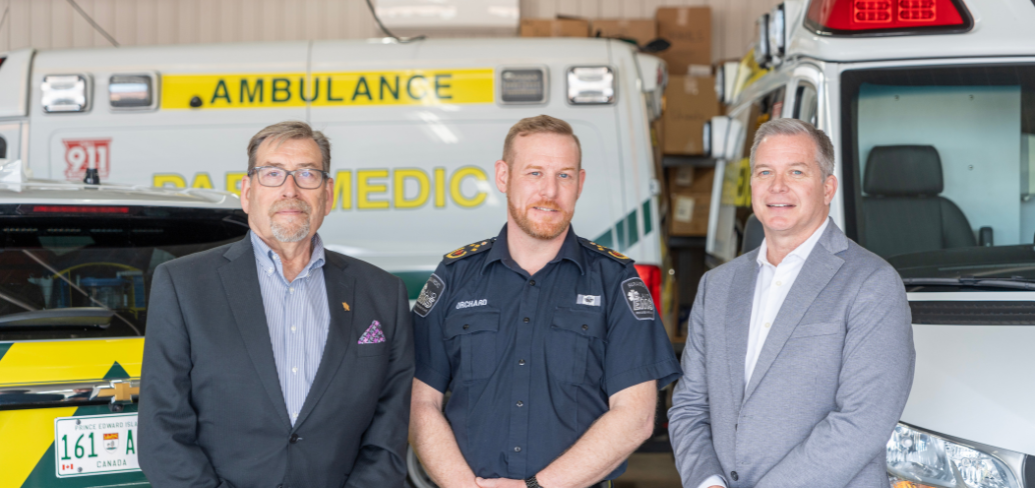New paramedic initiatives aimed at reducing ED visits and improving access to care

A new policy directive from the Department of Health and Wellness will give paramedics more ways to help Islanders access safe, high-quality care in their communities.
Effective May 7, 2024, Island EMS will introduce new protocols to determine whether people should receive care in the community or at the emergency department (ED). Previously, paramedics were required to take all patients to the ED, including those who may be better served elsewhere. As many as 35 percent of patients would refuse transport, leaving them on their own to access further care.
Now, when Islanders call 911, paramedics will support these patients by connecting them to more ways to receive care, including services like prescription refills, community paramedicine (paramedics treating patients on site) or access to other health care professionals.
As part of this initiative to build capacity and relieve system pressure, the Department of Health and Wellness and Island EMS are introducing Community Paramedic Response Units (CPRUs) that will provide comprehensive care in the community.
CPRUs are staffed by an Advanced Care Community Paramedic and are supported by physician oversight. The CPRU team is equipped with all the required medical equipment to provide diagnostics and treatments in a patient’s home. Islanders will also receive ongoing follow up, in the comfort of their home, from the CPRU team and be connected to appropriate care within the community.
This provincial initiative is modeled on similar programs that have been successfully launched across the country to provide care outside of the ED.
Quotes:
“The new policy will connect Island residents to the appropriate care pathways, whether that be through pharmacy, community paramedicine, or access to other health care professionals. Paramedics will ensure safe, timely and high-quality care for patients that are being treated at home; all patients will receive a follow-up call within 24 hours to confirm that their healthcare needs have been met.”
- Hon. Mark McLane, Minister of Health and Wellness
“More than one third of Islanders who call 911 do not require transport to the emergency department, they are looking for support in navigating the health care system. This initiative will reduce ambulance off-load delays and create more capacity for emergency response ensuring that paramedics continue to provide timely care to high-risk patients.”
- James Orchard, General Manager of PEI Operations, Island EMS
“This model will enhance patient safety and provide Islanders with the right care, by the right provider, in the right place, at the right time. In doing so, paramedics will do their part in reducing unnecessary emergency department visits while improving ambulance coverage for life-threatening emergencies in our communities. This will help ensure a better patient experience in the community and our hospitals.”
- Melanie Fraser, Chief Executive Officer, Health PEI
Media contacts:
Morgan Martin
Senior Communications Officer
Health and Wellness
mxmartin@gov.pe.ca (link sends e-mail)
Samantha Hughes
Senior Advisor, Communications & Stakeholder Relations
Medavie Health Services
samantha.hughes@medaviehs.com (link sends e-mail)
Everton McLean
Chief Communications Officer
Health PEI
emaclean@gov.pe.ca (link sends e-mail)
Backgrounder:
Examples of similar models across Canada leading to positive patient outcomes:
- In British Columbia, the Clinical Hub program focuses on providing alternate assessment and care alternatives for patients who may not need transport to hospital. This helps ensure that BCEHS ambulances are available for the most critically ill and injured patients, while low acuity patients get the right care for their needs, instead of facing long wait times in dispatch queues and emergency rooms. This program has received a national award for innovation.
- Ontario has launched various patient care models to divert patients away from the ED. For example, under the Treat and Refer model, an eligible patient may be treated by paramedics on scene as needed and referred for appropriate follow-up care by a healthcare provider (for example, community paramedicine).
- Alberta also leverages alternative modes of transportation for non-emergency transfers to hospital. Alberta Health Service estimates the program frees up 70 ambulance trips across the province every day.
Stay Connected:
Follow the Government of Prince Edward Island on Facebook (link is external), X (link is external), LinkedIn (link is external), YouTube (link is external) and Instagram (link is external).